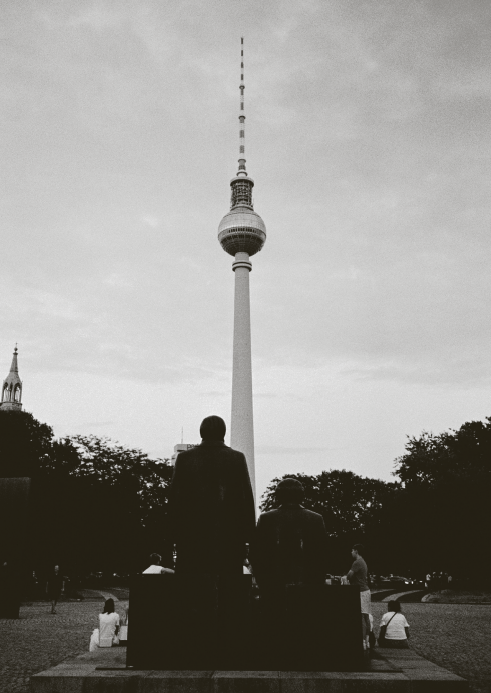“But it doesn’t work, look at the last time”
Whoever criticizes capitalism has sooner or later been confronted with this phrase.
A lot of responses to a fundamental criticism of existing social relations point to the failure of so-called “actual existing socialism” in the Soviet Union and the GDR as “proof” that there are no alternatives to capitalism. “Look, maybe capitalism isn’t brilliant,” so the argument goes, “but any other way of organizing human society inevitably ends up in a dictatorship.”
A lot of leftists in return think that this is a stupid argument and that one doesn’t need to deal with this brand of so-called socialism and its crimes. But if we’re looking for an alternative to capitalism it’s clear that we can’t avoid dealing with the problem of what was once called ‘communism’ or ‘actually existing socialism’ by people on both sides: its opponents in the West and its representatives in the East. Our aim here is not to discredit the search for a fundamentally different model of society – , one which is based on the needs of human beings – and we certainly won’t be equating the states of the Eastern Bloc with the Nazi regime. Instead, we want to make it clear that our idea of a communist society actually has very little in common with either of the former dictatorships.
But what exactly was this ‘actually existing socialism’? According to those in power in those days, the people had embarked on a path towards the construction of a classless, egalitarian society. But since this classless society had obviously not been achieved yet, they called it ‘actually existing socialism’ instead.
‘Actually existing socialism’ I: Dictatorship over rather than of the proletariat
When Karl Marx deals with the transition from capitalist to communist systems, he speaks of a period of the ‘dictatorship of the proletariat’. During this stage, the proletarians who have come to power are compelled to defend the revolution from the former ruling class. Once this danger has been dispelled, the institutions necessary for doing so, such as the state and military apparatus, wither away because they are simply no longer needed.
The rulers of the Eastern Bloc states appealed to this ‘dictatorship of the proletariat’ as the ideological justification for their instruments of rule and structures of power. In the course of events, the demand for broad-based self-determination on the part of working people actually turned into its exact opposite: the dictatorship of party bureaucracy over the vast majority of the population.
Under Lenin’s leadership in 1917, the October Revolution led to the Bolshevist faction of the Social Democratic Workers’ Party taking over government. Immediately afterwards, the people managed to establish real popular self-determination for the first time. This was clear, for example, in the fact that workers were able to plan industrial production themselves, collaboratively, whereas previously they had always had to implement orders handed down from above.
But this phase didn’t last long. It was soon brought to an end by the dictatorship of a small party clique, a system introduced by Lenin and taken to its extremes by Stalin. After Stalin’s death, the personality cult that had developed around him and the Soviet leadership was abandoned, and a period of ‘destalinization’ began. Crimes that had been committed by the state were also addressed to a certain extent, though the authoritarian rule of the party bureaucracy over the population and extensive control of almost every area of life nevertheless continued in all the Eastern Bloc countries.
‘Actually existing socialism’ II: Liberation through instead of from labor
The Eastern Bloc countries promised their inhabitants an economic system that would function without mass unemployment, without the principle of competition, and without exploitation. But in fact, the Eastern Bloc countries failed to develop a proper communist economic system. There was actually no fundamental break with the principles that determine capitalist economies.
It would be more accurate to say that those in power in these countries imitated the mechanisms of capitalism. They essentially just changed the company name from ‘private company’ to ‘nationally owned company’. The basic criteria of capitalist production – exchange, money, wages, and profit – were not really called into question. This is clear enough from the fact that even the ‘actually existing socialist’ states were in competition with one another and the capitalist states and even used military means to obtain spheres of influence at a global level. Those in power in these so-called socialist states were in fact eager to compete with capitalism in its most central categories: the pressure to work, the need to be efficient nevermind the effect on people. Pretty idiotic – so no big surprise that capitalism won this game in the end.
In everyday life under ‘actually existing socialism’ these developments manifested themselves, amongst other things, in the predominance of a fully-fledged labor fetishism. People were set to work simply to expand the wealth of the state, rather than that of the population. Others had to do largely pointless or superfluous work in order to create the impression of ‘full employment’. Thus labor became more than a necessary evil that you only do when it has to be done. People had to work just as much as they had under capitalism.
‚Actually existing Socialism’ III: Hard-working bodies, hardened souls
This fetishization of work was only one part of this so-called socialist ideal. Hard work was also supposed to toughen the body, and the demand for a moralistic and ascetic way of life was reminiscent of the dreary and oppressive atmosphere of protestant churches. But when every sign of weakness is condemned and every demonstration of emotions labeled as ‘petty bourgeois’, the necessary foundations of a society that is based on needs cannot be laid: the capacity for empathy, non-authoritarian behavior and an attempt at non-violent and needs-based communication. Now, why do we come up with this point? Because we see that whoever wants to be successful in capitalism has to toughen up and strengthen those bits of him- or herself that are authoritarian and violent. That doesn’t mean calling for everyone to be ‚good‘ and altruistic. There’s already enough altruism in our society, leading people to willingly die for ‘their’ nation. No, what is needed is an interest in realizing one’s own needs and bringing these desires across in a non-violent manner. In our experience, the realization of one’s own authoritarian ways can be quite scary. But it is the first step toward changing them. So, back to ‘actually existing socialism’ and its cult of toughness: An authoritarian personality developed that was comparable to capitalist society. Therefore, we are not surprised what cruelties people who called themselves ‘communist’ were capable of doing. A society that is not interested in supporting people’s capability for empathy and instead advocates and is built on authoritarianism and toughness is the very opposite of what we would call an emancipatory society.
‘Actually existing Socialism’ IV: Was failure inevitable?
When people criticize the former Eastern dictatorships, others object that they emerged out of seriously difficult circumstances. Their starting conditions are supposed to have been far more difficult than those of their competitors in the West.
And indeed: the October Revolution in Russia happened despite severe pressure from the capitalist powers in Europe. The West supported internal enemies of the revolution – the ‘white’ counter-revolutionary groups – as much as it possibly could. In particular, Germany – which would become Nazi Germany a few years later – exerted an enormous amount of pressure on the Soviet leadership. They had to press on with industrialization, and with no small human sacrifice, in order to arm the country against an expected attack.
There is a kernel of truth to all these explanations. But they overlook the fact that revolutions always happen under very difficult conditions. A politics created under such circumstances must be prepared to deal with these problems rationally. Even within the communist parties at the time there were calls to create a liberated society of individuals coming together of their own free will. On sober reflection then, and to judge by these standards, ‘actually existing socialism’ clearly failed.
But pointing out these adverse circumstances should not give the false impression that the power structures of ‘actually existing socialism’ were based entirely on Lenin’s Bolshevik ideology. ‘Democratic centralism’ does not inevitably lead to Stalinism. In practice, Lenin’s ‘vanguard party’ was indeed the authoritarian rule of professional revolutionaries over their party base. This was for example evident from the fact that opposition was not permitted even within the party, and that the party base was strictly bound to the decisions of the party leadership.
In our view, purges come as no surprise within a party whose central doctrine of Historical Materialism sees itself as the vanguard of inevitable historical change. „Necessary processes“ which stagnate or fail can be explained in two different ways. The first option is that such changes were ultimately not necessary after all. But unfortunately very few took this view, whether Lukács, left communists like Gorter or Pannekoek or Critical Theory. The other explanation starts with a search for the „culprits“ for the failure. This explains the terribly long list of supposed counterrevolutionaries within the Communist Party of the Soviet Union and other countries. In this view of history, it is no surprise that Stalin and company became the biggest murderers of communists in all of history.
What now?
Even if our reasons for addressing the issue of ‘actually existing socialism’ are entirely different from those of the political mainstream, in our view this project was indeed a catastrophe. But it would be stupid to conclude from this that the search for alternatives isn’t worth the effort. The capitalist system we live under means constant terror. This terror takes the form of war, poverty, and oppression in the so-called ‘developing countries’, but also increasingly in the capitalist metropoles. One doesn’t even have to mention the 30 000 people that die because of capitalism every day in order to point out that the search for alternatives to this economic system cannot wait one day longer.
For further reading:
– Hermann Gorter/Anton Pannekoek/Sylvia Pankhurst: Non-Leninist Marxism: Writings on the Worker’s Councils
Historical Materialism – an anti-revolutionary theory of revolution
– Arno Lustiger: Stalin and the Jews. 450 p., Enigma Books.


